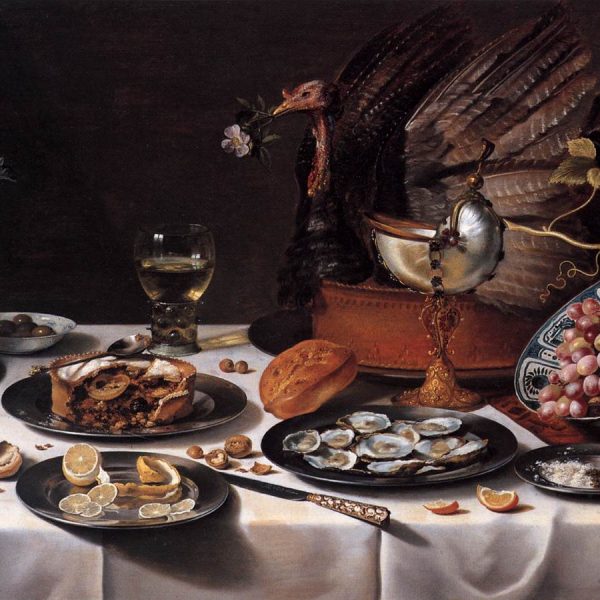
bon appetit!
You might want to consider grabbing a quick lunch before reading on! Otherwise, the paragraphs that follow may make your stomach rumble. And that’s because we’re in for a real feast, and the main course today is artwork depicting food. Things will get appetizing, occasionally even exquisite. Fortunately, the menu is very diverse, so there’s something for everyone!
The first item on the menu is the still lifes of seventeenth-century Dutch artists. What’s unique about the paintings of that period is their photorealism, as can be easily observed by looking at the representations of flowers, fruit and sumptuous dishes served on precious platters. The paintings feature juicy grapes, fresh clams, pheasants and sweet delicacies, all so realistic that one wants to reach out and snatch them from behind the canvas! But the message behind these compositions is in fact as baroque as it gets – just as food spoils quickly, so will our lives pass in the blink of an eye.
To catch some breath after the last heavy meal, let’s go for a run a few hundred years forward, to stop at the beginning of the twentieth century. This is to show yo that food wasn’t only the preserve of old painters and that avant-garde artists turned to it with as much enthusiasm. For them however, fruit, vegetables, fish and meat laid out on fancy platters were a pretext to accentuate the art movements which they subscribed to. And so the Fauvists would opt for strong, aggressive colors, which they applied to the canvas with bold strokes, while the Cubists attempted to present spatial objects in a flat image by splitting their shapes into several planes. Even though the dishes coming from under these artists’ brushes aren’t exactly what we would call realistic, they still fit into the convention of traditional still lifes.
Another culinary revival was brought by pop art. The most memorable examples include iconic objects such as Andy Warhol’s Campbell’s soup can, raised by the very author to the rank of art, as well as his famous banana on a white background or Coca-Cola bottles. This simple, graphic form is an obvious reference to advertisements for food products. Another noteworthy artist with a taste for food is Claes Oldenburg whose large-scale plastic sculptures depict some of everyone’s favorite guilty-pleasure meals, that is fast food and desserts: there’s burgers, pizza, cream cakes, you name it. Interestingly, the material used by the artist makes his works anything but appetizing and instead more reminiscent of inflatable pool toys.
As you’re about to find out, our culinary journey through art has turned full circle in a rather interesting way. We have once again reached the point of hyper realistic compositions, and the Dutch still lifes that we started from are nowadays echoed in the works of the contemporary Dutch artist Tjalf Sparnaay. His sandwiches and Belgian fries delight viewers with their photorealism, just like the paintings of Pedro Campos among which the composition with Coke cans was the one that really caught my eye. What makes this and other similar works so unforgettable is the contrast they create between oil painting, typically associated with fine art, and the apparent triviality of the modern subject matter.
And that’s about it. We can only hope you didn’t get too hungry while reading about all these delicious artworks.
transl. Jakub Majchrzak








